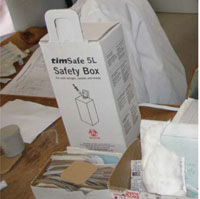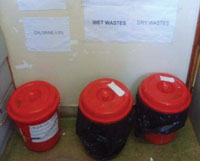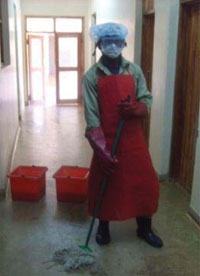26.1.2 Specific universal precautions
Universal precautions include the following measures and actions:
- Increased attention to the correct handling of sharps and all infected materials. The safe disposal of sharps (e.g. needles, scalpels, lances and suture materials) is relatively easy to achieve. Home-made containers that have an open top, firm sides, and are made of durable materials, can be used as containers for used sharps (Figure 26.1).
![]() Never fill a safety box beyond three-quarters full. Beyond this point you risk an injury when adding more sharps to the box!
Never fill a safety box beyond three-quarters full. Beyond this point you risk an injury when adding more sharps to the box!

- Safe disposal of waste contaminated with blood or body fluids. Contaminated clinical waste includes used bandages, dressings, and linens or materials contaminated with blood or body fluids; these must all be handled with gloved hands and placed in containers for safe disposal, as shown in Figure 26.2.

- Hand washing with soap and water before and after all procedures. This is the single most important step that all healthcare workers can take to ensure the safety of their patients and themselves. You must wash your hands before and after putting on gloves, and before and after you move from one patient to another.
- Use of protective barriers (personal protective equipment or PPE) when in direct contact with potentially infected body fluids. Protective barriers such as gloves, gowns, masks and goggles protect healthcare workers from occupational exposure to infectious material (see example in Figure 26.3). Gloves provide an important barrier between infectious material and the healthcare provider. Using gloves does not mean that you don’t have to wash your hands.

- Proper disinfection of instruments and other contaminated equipment. In an effort to make universal procedures routine, more emphasis is put on preventing the transfer of infection from one patient to another by proper disinfection of instruments and contaminated equipment.
26.1.1 Why are universal precautions needed?
